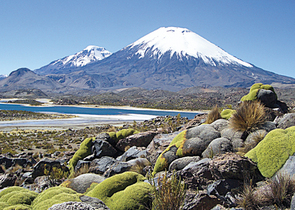Nature Conservation 3/2011 — 7. 10. 2011 — International Nature Conservation — Print article in pdf
The Lauca National Park

The Lauca National Park (NP) is located in Chile’s far north, in the Andean range near the Bolivian border. It encompasses an area of 1,379 km2of altiplano and mountains, the latter consisting mainly of enormous volcanoes. From the Park it is possible to watch the Parinacota (6,342 m), the Pomerape (6,282 m) and the Guallatiri (6,060 m) volcanoes.
A major attraction of the park is the astonishing Chungara Lake, one of the most elevated of the world, located at the foot of the Payachata twin volcanoes. Both plants and animals have effectively adapted to the harsh puna environment there. Mammals in the NP include the Vicuna (Vicugna vicugna), Alpaca (Lama guanicoe/Vicugna vicugnaf. pacos), Guanaco (Lama guanicoe), Cougar (Puma concolor), also known as the Puma or the Silver Lion, and the Viscacha (Logidium peruanum), the latter being closely related to chinchillas, and looking similar to rabbits. Within the NP, 130 bird species have been found, i.e.one third of the whole Chilean bird fauna. Among them, the Darwins Rhea (Pterocnemia pennata) and the flamingos (the Chilean Phoenicopterus chilensis, Andean P. andinusand the Jamess Flamingo P. jamesi) should be mentioned. The Lauca National Parks future is threatened by possible mining activities.

